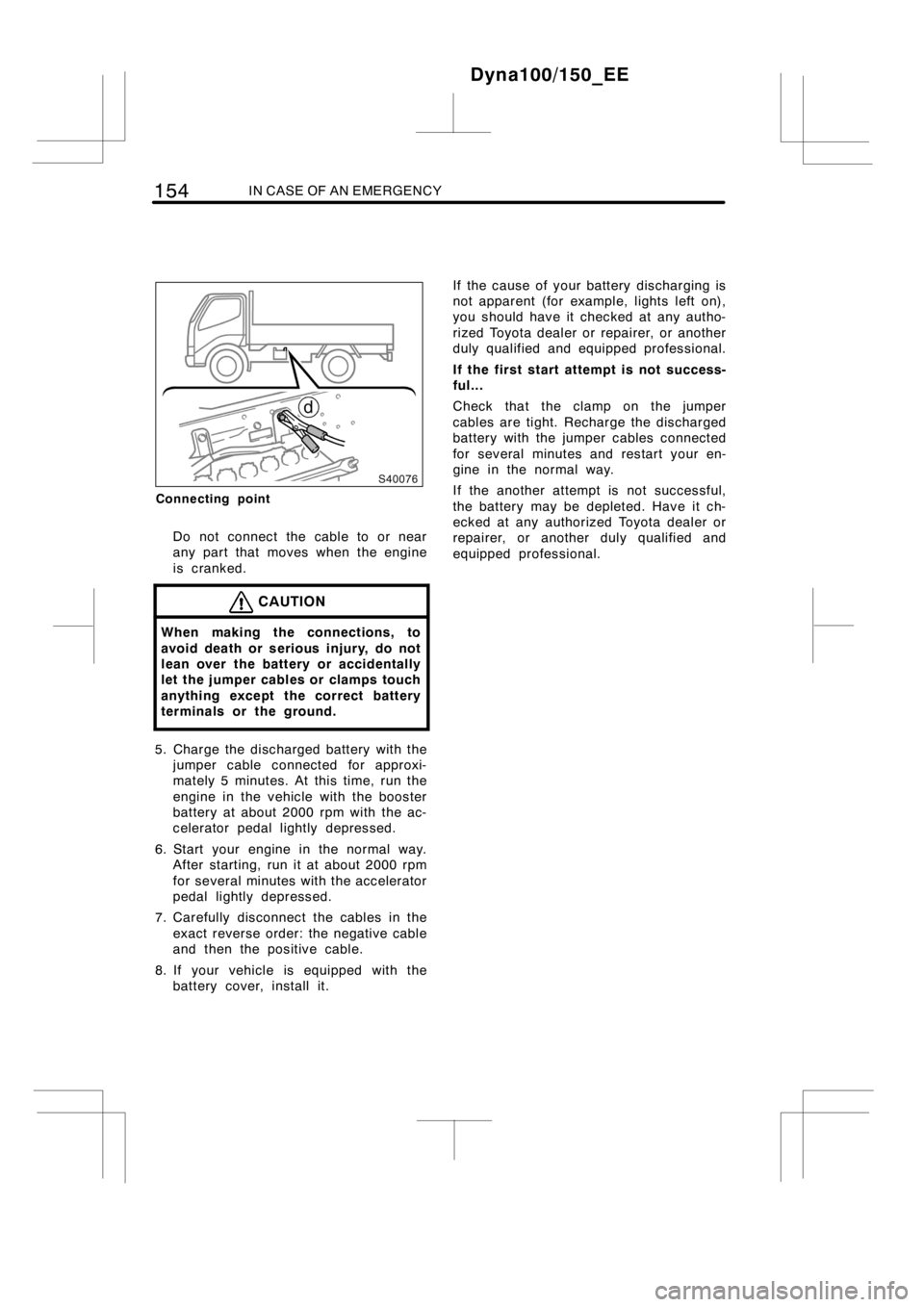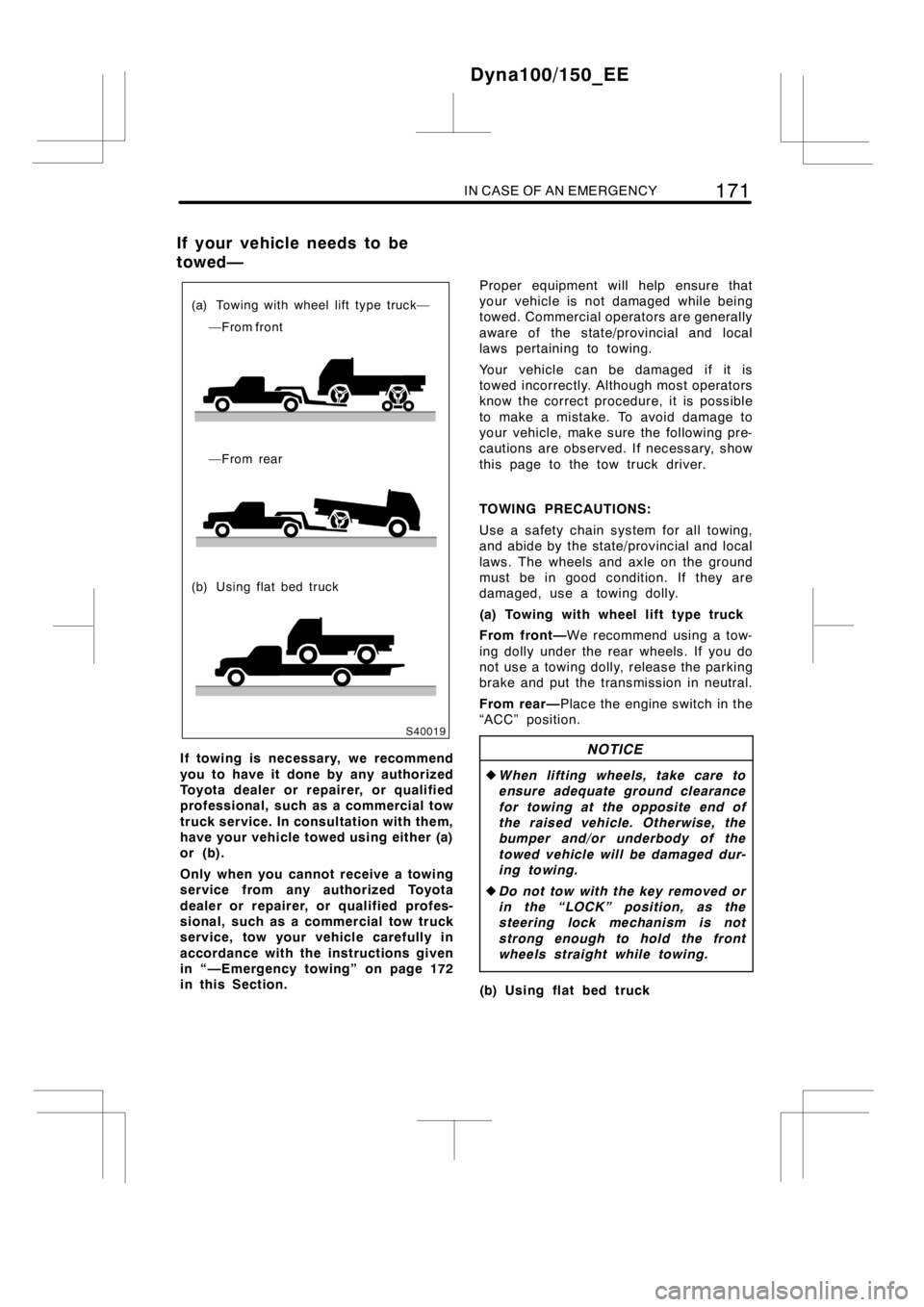engine TOYOTA DYNA 100/150 2012 (in English) Manual PDF
[x] Cancel search | Manufacturer: TOYOTA, Model Year: 2012, Model line: DYNA 100/150, Model: TOYOTA DYNA 100/150 2012Pages: 240, PDF Size: 15.05 MB
Page 156 of 240

150IN CASE OF AN EMERGENCY
Before making these checks, make sure
you have followed the correct starting pro-
cedure given in “How to start the engine”
on page 132 in Section 3 and that you
have sufficient fuel.
If the engine is not turning over or is
turning over too slowly—
1. Check that the battery terminals are
tight and clean.
2. If the battery terminals are O.K., switch
on the interior light.
3. If the light is out, dim or goes out
when the starter is cranked, the battery
is discharged. You may try jump start-
ing. See “(c) Jump starting” on page
151 for further instructions.
If the light is O.K., but the engine still will
not start, it needs adjustment or repair.
Call any authorized Toyota dealer or re-
pairer, or another duly qualified and
equipped professional.
NOTICE
Do not pull−or push−start the ve-
hicle. It may damage the vehicle or
cause a collision when the engine
starts. Also, the catalytic converter
may overheat and become a fire haz-
ard.
If the engine turns over at its normal
speed but will not start—
1. If you are starting the engine that has
died from an empty tank, you may
have needed to bleed the fuelsystem
before cranking the engine. See “(b)
Bleeding the fuelsystem” onpage 150
for further instructions.
2. If the fuel system is O.K., but the
engine still will not start, it needs ad-
justment or repair. Call any authorized
Toyota dealer or repairer, or another
duly qualified and equipped profession-
al, for assistance.
If you run out of fuel and the engine
dies, the engine may not restart after
refueling. In such case, operate the
priming pump until you feel more resis-
tance.
Dyna100/150_EE
If your vehicle will not start—
(a) Simple checks(b) Bleeding the fuel system
Page 157 of 240

IN CASE OF AN EMERGENCY151
To avoid serious injury and damage to
your vehicle which might result from
battery explosion, acid burns, electrical
burns, or damaged electronic compo-
nents, these instructions must be fol-
lowed precisely.
If you are unsure about how to follow this
procedure, we strongly recommend that
you seek the help of a competent me-
chanic or towing service.
CAUTION
DBatteries contain sulfuric acid
which is poisonous and corrosive.
Wear protective safety glasses when
jump starting, and avoid spilling
acid on your skin, clothing, or ve-
hicle.
DIf you should accidentally get acid
on yourself or in your eyes, remove
any contaminated clothing and flush
the affected area with water imme-
diately. Then get immediate medical
attention. If possible, continue to
apply water with a sponge or cloth
while en route to the medical office.
DThe gas normally produced by a
battery will explode if a flame or
spark is brought near. Use only
standardized jumper cables and do
not smoke or light a match while
jump starting.
NOTICE
The battery used for boosting must
be 12 V. Do not jump start unless you
are sure that the booster battery is
correct.
JUMP STARTING PROCEDURE
1. If your vehicle is equipped with the
battery cover, remove it.
2. If the booster battery is installed in
another vehicle, make sure the vehicles
are not touching. Turn off all unneces-
sary lights and accessories.
When boosting, use the battery of
matching or higher quality. Any other
battery may be difficult to jump start
with.
If jump starting is difficult, charge the
battery for several minutes.
3. If the engine in the vehicle with the
booster battery is not running, start it
and let it run for a few minutes. During
jump starting, run the engine at about
2000 rpm with the accelerator pedal
lightly depressed.
Dyna100/150_EE
(c) Jump starting
Page 160 of 240

154IN CASE OF AN EMERGENCY
Connecting point
Do not connect the cable to or near
any part that moves when the engine
is cranked.
CAUTION
When making the connections, to
avoid death or serious injury, do not
lean over the battery or accidentally
let the jumper cables or clamps touch
anything except the correct battery
terminals or the ground.
5. Charge the discharged battery with the
jumper cable connected for approxi-
mately 5 minutes. At this time, run the
engine in the vehicle with the booster
battery at about 2000 rpm with the ac-
celerator pedal lightly depressed.
6. Start your engine in the normal way.
After starting, run it at about 2000 rpm
for several minutes with the accelerator
pedal lightly depressed.
7. Carefully disconnect the cables in the
exact reverse order: the negative cable
and then the positive cable.
8. If your vehicle is equipped with the
battery cover, install it.If the cause of your battery discharging is
not apparent (for example, lights left on),
you should have it checked at any autho-
rized Toyota dealer or repairer, or another
duly qualified and equipped professional.
If the first start attempt is not success-
ful...
Check that the clamp on the jumper
cables are tight. Recharge the discharged
battery with the jumper cables connected
for several minutes and restart your en-
gine in the normal way.
If the another attempt is not successful,
the battery may be depleted. Have it ch-
ecked at any authorized Toyota dealer or
repairer, or another duly qualified and
equipped professional.
Dyna100/150_EE
Page 161 of 240

IN CASE OF AN EMERGENCY155
If your engine stalls while driving...
1. Reduce your speed gradually, keeping
a straight line. Move cautiously off the
road to a safe place.
2. Turn on your emergency flashers.
3. Try starting the engine again.
If the engine will not start, see “If your
vehicle will not start” on page 150.
CAUTION
If the engine is not running, the pow-
er assist for the brakes and steering
will not work so steering and braking
will be much harder than usual.
If engine speed does not increase when
the accelerator pedal is depressed, there
may be a problem somewhere in the elec-
tronic engine controlsystem. Stop the ve-
hicle and contact any authorized Toyota
dealer or repairer, or another duly quali-
fied and equipped professional, or take
your vehicle carefully, since the vehicle
performance will be lower than normal, to
any authorized Toyota dealer or repairer,
or another duly qualified and equipped
professional, as soon as possible.
Even if the abnormality in the electronic
engine controlsystem is corrected during
low speed driving, thesystem may not
recover until the engine is stopped and
the engine switch is turned to the “ACC”
or “LOCK” position.
Dyna100/150_EE
If your engine stalls while
drivingIf you cannot increase engine
speed
Page 162 of 240

156IN CASE OF AN EMERGENCY
If your engine coolant temperature
gauge indicates overheating, if you ex-
perience a loss of power, or if you hear
a loud knocking or pinging noise, the
engine has probably overheated. You
should follow this procedure...
1. Pull safely off the road, stop the ve-
hicle, and turn on your emergency
flashers. Put the transmission in neu-
tral and apply the parking brake. Turn
off the air conditioning if it is being
used.
2. If coolant or steam is boiling out of the
radiator or reservoir, stop the engine.
Wait until the steam subsides before
opening the engine access hole cover
or tilting the cab. If there is no coolant
or steam boiling over, leave the engine
running and make sure the electric
cooling fan is operating. If it is not,
turn the engine switch off.
CAUTION
To help avoid serious injury, keep the
engine access hole cover closed or
the cab lowered until there is no
steam. Escaping steam or coolant is
a sign of very high pressure.
3. Visually check to see if the engine
drive belt (fan belt) is broken or loose.
Look for obvious coolant leaks from the
radiator, hoses, and under the vehicle.
However, note that water draining from
the air conditioning is normal if it has
been used.
CAUTION
When the engine is running, keep
hands and clothing away from the
moving fan and engine drive belts.
4. If the engine drive belt is broken or the
coolant is leaking, stop the engine im-
mediately. Call any authorized Toyota
dealer or repairer, or another duly qual-
ified and equipped professional, for as-
sistance.
5. If the engine drive belt is O.K. and
there are no obvious leaks, you may
help the engine cool down more quickly
by running it at about 1500 rpm for a
few minutes with the accelerator pedal
lightly depressed.
6. Check the coolant reservoir. If it is dry,
add coolant to the reservoir while the
engine is running. Fill it about half full.
For the coolant type, see “Coolant type
selection” on page 199 in Section 7−2.
CAUTION
Do not attempt to remove the radiator
cap when the engine and radiator are
hot. Serious injury could result from
scalding hot fluid and steam blown
out under pressure.
7. After the engine coolant temperature
has cooled to normal, again check the
coolant level in the reservoir. If neces-
sary, bring it up to half full again.
Serious coolant loss indicates a leak in
the system. You should have it
checked as soon as possible at any
authorized Toyota dealer or repairer, or
another duly qualified and equipped
professional.
Dyna100/150_EE
If your vehicle overheats
Page 163 of 240

IN CASE OF AN EMERGENCY157
1. Reduce your speed gradually, keeping
a straight line. Move cautiously off the
road to a safe place well away from
the traffic. Avoid stopping on the center
divider of a highway. Park on a level
spot with firm ground.
2. Stop the engine and turn on your
emergency flashers.
3. Firmly set the parking brake and put
the transmission in reverse.
4. Have everyone get out of the vehicle
onthesideawayfromtraffic.
5. Read the following instructions thor-
oughly.
CAUTION
When jacking, be sure to observe the
following to reduce the possibility of
death or serious injury:
DFollow jacking instructions.
DDo not put any part of your body
under the vehicle supported by the
jack. Otherwise, death or serious
injury may occur.
DDo not start or run the engine while
your vehicle is supported by the
jack.
DStop the vehicle on a level firm
ground, firmly set the parking brake
and put the transmission in reverse.
Block the wheel diagonally opposite
to the one being changed if neces-
sary.
DMake sure to set the jack properly
in the jack point. Raising the ve-
hicle with jack improperly posi-
tioned will damage the vehicle or
may allow the vehicle to fall off the
jack and cause death or serious in-
jury.
DNever get under the vehicle when
the vehicle is supported by the jack
alone.
DUse the jack only for lifting your
vehicle during wheel changing.
DDo not raise the vehicle with some-
one in the vehicle.
DWhen raising the vehicle, do not
place any objects on top of or un-
derneath the jack.
DRaise the vehicle only high enough
to remove and change the tire.
NOTICE
Do not continue driving with a de-
flated tire. Driving even a short dis-
tance can damage a tire and wheel
beyond repair.
Dyna100/150_EE
If you have a flat tire—
Page 176 of 240

170IN CASE OF AN EMERGENCY
11. Check the air pressure of the re-
placed tire.
Adjust the air pressure to the specification
designated on page 226 in Section 8. If
the pressure is lower, drive slowly to the
nearest service station and fill to the cor-
rect pressure.
Do not forget to reinstall the tire inflation
valve cap as dirt and moisture could get
into the valve core and possibly cause air
leakage. If the cap is missing, have a new
one put on as soon as possible.
12. Restow all the tools, jack and flat
tire securely.
Front and single rear tires—
As soon after changing wheels as pos-
sible, tighten the wheel nuts to the torque
specified on page 226 in Section 8 with
a torque wrench. Have a technician repair
the flat tire.
Double rear tires—
As soon after changing wheels as pos-
sible, tighten the stop bolts and wheel
nuts to the torque specified on page 226
in Section 8 with a torque wrench. Have
a technician repair the flat tire.
This is the same procedure for changing
or rotating your tires.
CAUTION
Before driving, make sure all the
tools, jack and flat tire are securely
in place in their storage location to
reduce the possibility of death or se-
rious injury during sudden braking,
sudden swerving or an accident.
If your vehicle becomes stuck in snow,
mud, sand, etc., then you may attempt
to rock the vehicle free by moving it
forward and backward.
CAUTION
Do not attempt to rock the vehicle
free by moving it forward and back-
ward if people or objects are any-
where near the vehicle. During the
rocking operation the vehicle may
suddenly move forward or backward
as it becomes unstuck, causing injury
or damage to nearby people or ob-
jects.
NOTICE
If you rock your vehicle, observe the
following precautions to prevent dam-
age to the transmission and other
parts.
zDo not race the engine and avoid
spinning the wheels.
zIf your vehicle remains stuck after
rocking the vehicle several times,
consider other ways such as tow-
ing.
Dyna100/150_EE
—After changing wheelsIf your vehicle becomes
stuck
Page 177 of 240

IN CASE OF AN EMERGENCY171
(a) Towing with wheel lift type truck—
—From front
—From rear
(b) Using flat bed truck
If towing is necessary, we recommend
you to have it done by any authorized
Toyota dealer or repairer, or qualified
professional, such as a commercial tow
truck service. In consultation with them,
have your vehicle towed using either (a)
or (b).
Only when you cannot receive a towing
service from any authorized Toyota
dealer or repairer, or qualified profes-
sional, such as a commercial tow truck
service, tow your vehicle carefully in
accordance with the instructions given
in “—Emergency towing” on page 172
in this Section.Proper equipment will help ensure that
your vehicle is not damaged while being
towed. Commercial operators are generally
aware of the state/provincial and local
laws pertaining to towing.
Your vehicle can be damaged if it is
towed incorrectly. Although most operators
know the correct procedure, it is possible
to make a mistake. To avoid damage to
your vehicle, make sure the following pre-
cautions are observed. If necessary, show
this page to the tow truck driver.
TOWING PRECAUTIONS:
Use a safety chain system for all towing,
and abide by the state/provincial and local
laws. The wheels and axle on the ground
must be in good condition. If they are
damaged, use a towing dolly.
(a) Towing with wheel lift type truck
From front—We recommend using a tow-
ing dolly under the rear wheels. If you do
not use a towing dolly, release the parking
brake and put the transmission in neutral.
From rear—Place the engine switch in the
“ACC” position.NOTICE
zWhen lifting wheels, take care to
ensure adequate ground clearance
for towing at the opposite end of
the raised vehicle. Otherwise, the
bumper and/or underbody of the
towed vehicle will be damaged dur-
ing towing.
zDo not tow with the key removed or
in the “LOCK” position, as the
steering lock mechanism is not
strong enough to hold the front
wheels straight while towing.
(b) Using flat bed truck
Dyna100/150_EE
If your vehicle needs to be
towed—
Page 179 of 240

IN CASE OF AN EMERGENCY173
If towing is necessary, we recommend
you to have it done by any authorized
Toyota dealer or repairer, or qualified
professional, such as a commercial tow
truck service.
If towing service is not available in an
emergency, your vehicle may be tempo-
rarily towed by a cable or chain se-
cured to one of the following parts:
Front: Front emergency towing hook
Rear: Rear emergency towing eyelet
Use extreme caution when towing the
vehicle.
NOTICE
Only use specified towing hook or
eyelet; otherwise your vehicle may be
damaged.
A driver must be in the vehicle to steer
it and operate the brakes.
Towing in this manner may be done only
on hard−surfaced roads for a short dis-
tance and at low speeds. Also, the
wheels, axles, drive train, steering and
brakes must all be in good condition.
CAUTION
Use extreme caution when towing the
vehicle. Avoid sudden starts or errat-
ic driving maneuvers which would
place excessive stress on the emer-
gency towing hook or eyelet and tow-
ing cable or chain. The hook or eye-
let and towing cable or chain may
break and cause serious injury or
damage.
NOTICE
Use only a cable or chain specifically
intended for use in towing vehicles.
Securely fasten the cable or chain to
the towing hook or eyelet provided.
Before towing, release the parking brake
and put the transmission in neutral. The
engine switch must be in “ACC” (engine
off) or “ON” (engine running) position.
CAUTION
If the engine is not running, the pow-
er assist for the brakes and steering
will not work so steering and braking
will be much harder than usual.
Dyna100/150_EE
Page 181 of 240

IN CASE OF AN EMERGENCY175
Only in an emergency, such as if it
becomes impossible to stop the vehicle
in the normal way, stop the vehicle us-
ing the following procedure:
1. Steadily step on the brake pedal with
both feet and firmly depress it. Do not
pump the brake pedal repeatedly as
this will increase the effort required to
slow the vehicle.
2. Shift the shift lever to neutral.
If the shift lever is shifted to neutral:
3. After slowing down, stop the vehicle in
a safe place by the road.
4. Stop the engine.
If the shift lever cannot be shifted to
neutral:
3. Keep depressing the brake pedal with
both feet to reduce vehicle speed as
much as possible.
4. Stop the engine by turning the engine
switch to the “ACC” position.
5. Stop the vehicle in a safe place by the
road.
CAUTION
If the engine has to be turned off
while driving:
DPower assist for the brakes and
steering wheel will be lost, making
the brake pedal harder to depress
and the steering wheel heavier to
turn. Decelerate as much as pos-
sible before turning off the engine.
DNever attempt to remove the key, as
doing so will lock the steering
wheel.
Dyna100/150_EE
If your vehicle has to be
stopped in an emergency